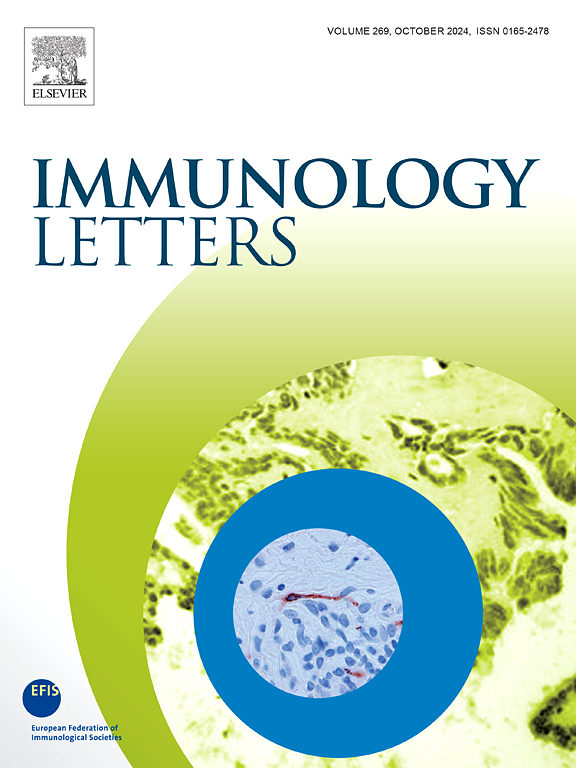x射线照射通过抑制巨噬细胞中TWIK2活性来减少atp依赖性NLRP3炎性体的激活。
IF 2.8
4区 医学
Q3 IMMUNOLOGY
引用次数: 0
摘要
背景:脾脏作为机体最大的外周免疫器官和循环单核细胞的重要来源,在脾源性巨噬细胞对疾病的急性炎症反应中起着重要作用。因此,研究x射线照射对脾源性巨噬细胞炎症反应的影响及其机制具有重要意义。方法:将提取鉴定的小鼠脾巨噬细胞分为4组:对照组、LPS与ATP共刺激未照射组、LPS与ATP共刺激6h后照射组、LPS与ATP共刺激12h后照射组。LPS和ATP共刺激组分别添加LPS (1μg/ml)和ATP (5mmol/L),建立小鼠脾巨噬细胞炎症模型。受辐照组暴露在医用直线加速器(Elekta Synergy)中,而未受辐照组则在光源下放置相同时间而不受辐照。各组分别于治疗后6h和12h进行蛋白提取,后续采用Western blot、ELISA、RT-qPCR等相关方法进行分析。结果:(1)与未照射组相比,8Gy照射6h和12h组细胞活性明显升高(p)。结论:x射线照射能够抑制脾巨噬细胞atp依赖性NLRP3炎性小体的激活。本文章由计算机程序翻译,如有差异,请以英文原文为准。

X-ray irradiation reduces ATP-dependent activation of NLRP3 inflammasome by inhibiting TWIK2 activity in macrophages
Background
The spleen, as the body's largest peripheral immune organ and a crucial source of circulating monocytes, plays a significant role in the acute inflammatory response of spleen-derived macrophages to diseases. Therefore, studying the impact and mechanism of X-ray irradiation on spleen-derived macrophages' inflammatory responses is of great importance.
Method
Extracted and identified mice splenic macrophages were divided into four groups: control group, LPS and ATP co-stimulated non-irradiated group, LPS and ATP co-stimulated group irradiated after 6 h, and LPS and ATP co-stimulated group irradiated after 12 h In the LPS and ATP co-stimulated groups, LPS (1μg/ml) and ATP (5mmol/L) were added to establish an inflammatory model in mice splenic macrophages. The irradiated groups were exposed to a medical linear accelerator (Elekta Synergy), while the non-irradiated groups were placed under the light source for the same duration without irradiation. Protein extraction was performed in each group at 6 h and 12 h post-treatment for subsequent analysis using Western blot, ELISA, RT-qPCR and other relevant methods.
Results
(1) Compared with the non-irradiated group, the cell activity in the groups irradiated for 6 h and 12 h at 8 Gy showed a significant increase (P<0.01). (2) In the LPS and ATP co-stimulated groups irradiated after 6 h and 12 h, the expression of NLRP3 mRNA and protein, IL-18 and IL-1β showed a notable decrease compared to the LPS and ATP co-stimulated non-irradiated group (P<0.05). Additionally, caspase-1 expression of caspase-1 mRNA and protein in the 12 h post-irradiation group also decreased considerably when compared with the LPS and ATP co-stimulated non-irradiated group (P < 0.05). In the groups irradiated after 6 h and 12 h, (3) there was a remarkable decrease in the expression of TWIK mRNA and TWIK2, (4) as well as Gq mRNA and protein, when compared to the LPS and ATP co-stimulated non-irradiated group (P < 0.05). Particularly, the 12 h post-irradiation group exhibited a notable reduction in PKC expression (P < 0.05).
Conclusion
X-ray irradiation is capable of inhibiting the activation of ATP-dependent NLRP3 inflammasomes in splenic macrophages.
求助全文
通过发布文献求助,成功后即可免费获取论文全文。
去求助
来源期刊

Immunology letters
医学-免疫学
CiteScore
7.60
自引率
0.00%
发文量
86
审稿时长
44 days
期刊介绍:
Immunology Letters provides a vehicle for the speedy publication of experimental papers, (mini)Reviews and Letters to the Editor addressing all aspects of molecular and cellular immunology. The essential criteria for publication will be clarity, experimental soundness and novelty. Results contradictory to current accepted thinking or ideas divergent from actual dogmas will be considered for publication provided that they are based on solid experimental findings.
Preference will be given to papers of immediate importance to other investigators, either by their experimental data, new ideas or new methodology. Scientific correspondence to the Editor-in-Chief related to the published papers may also be accepted provided that they are short and scientifically relevant to the papers mentioned, in order to provide a continuing forum for discussion.
 求助内容:
求助内容: 应助结果提醒方式:
应助结果提醒方式:


